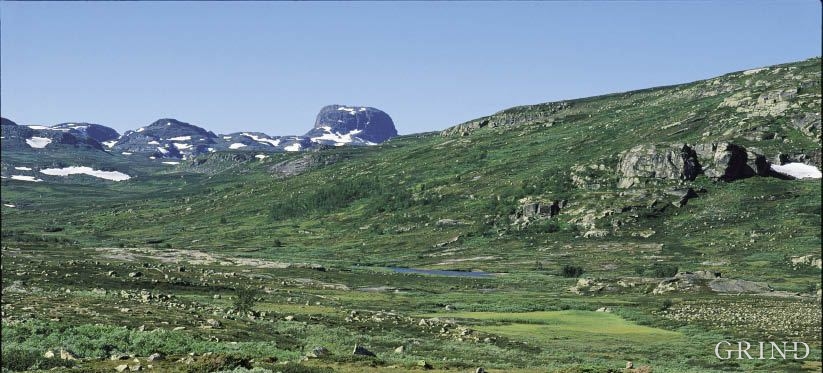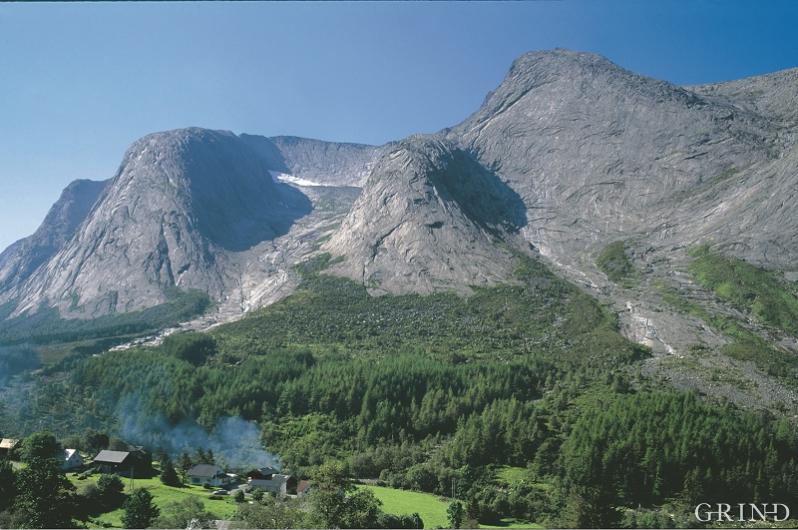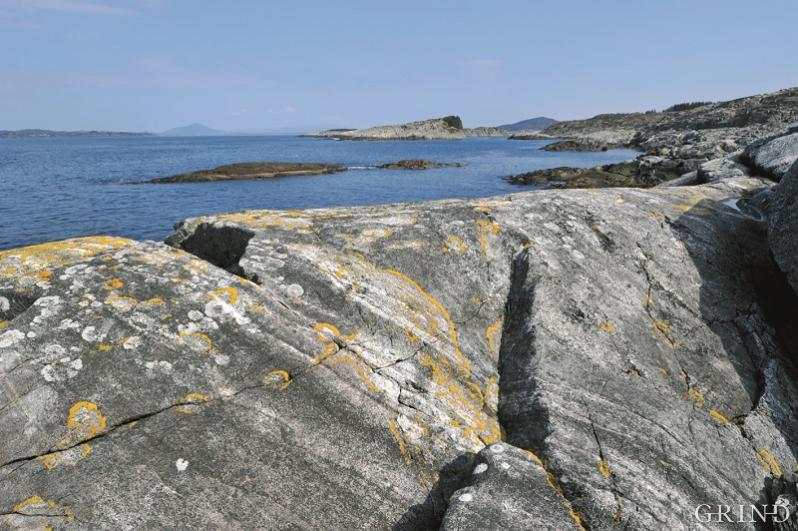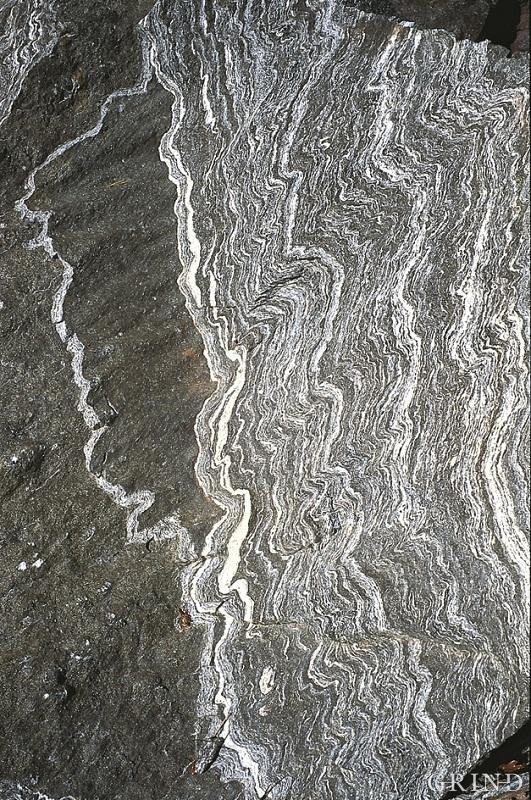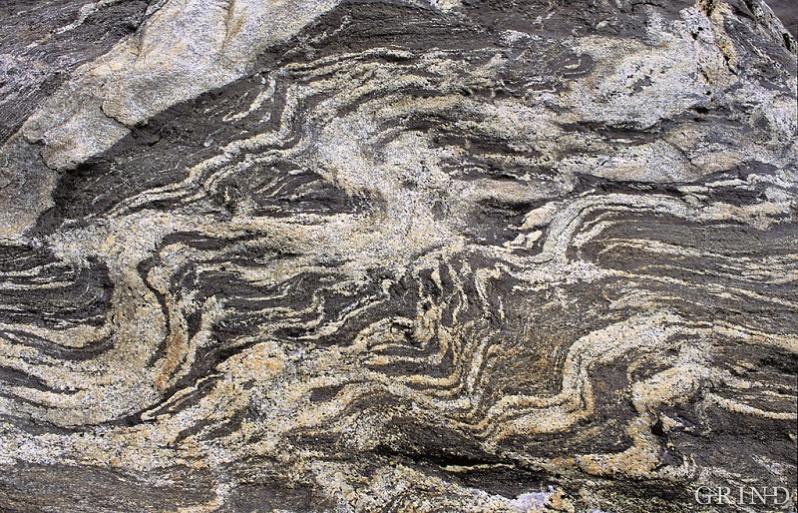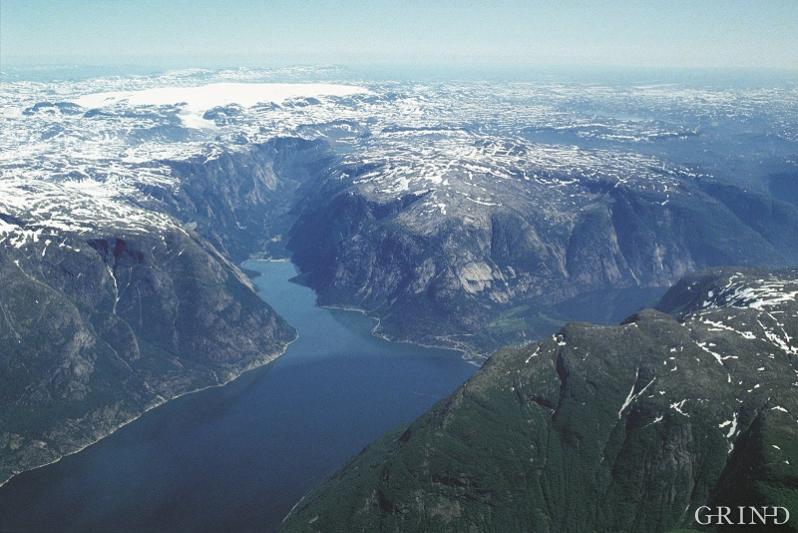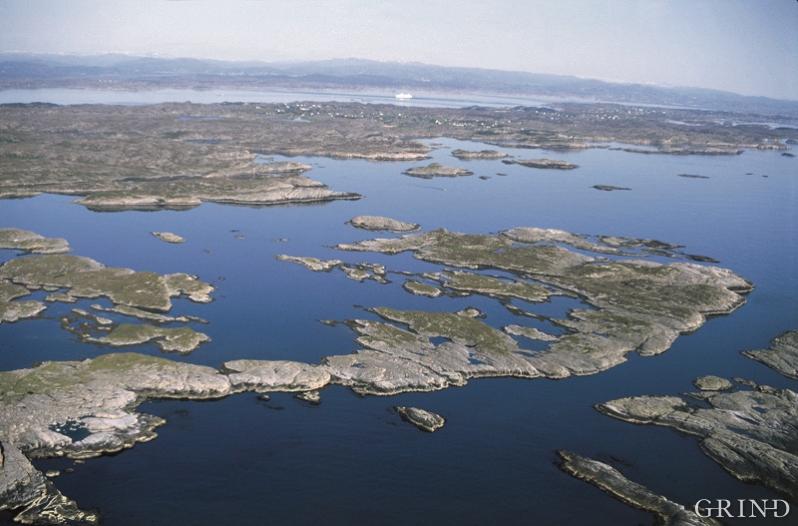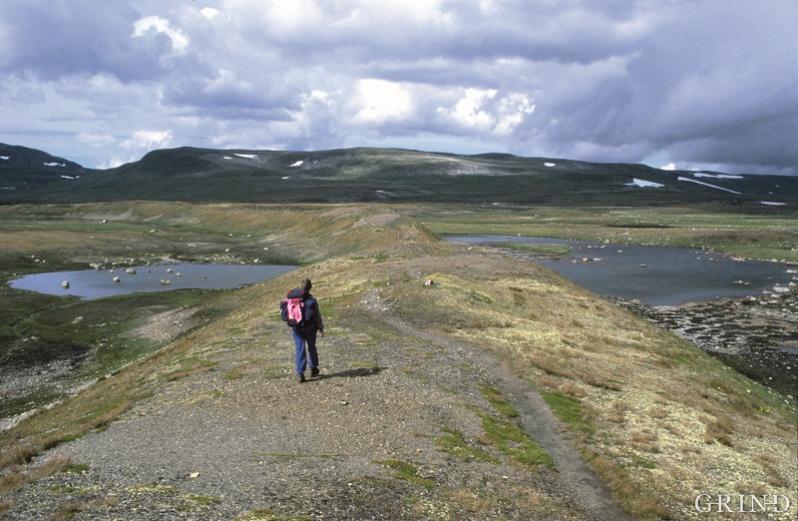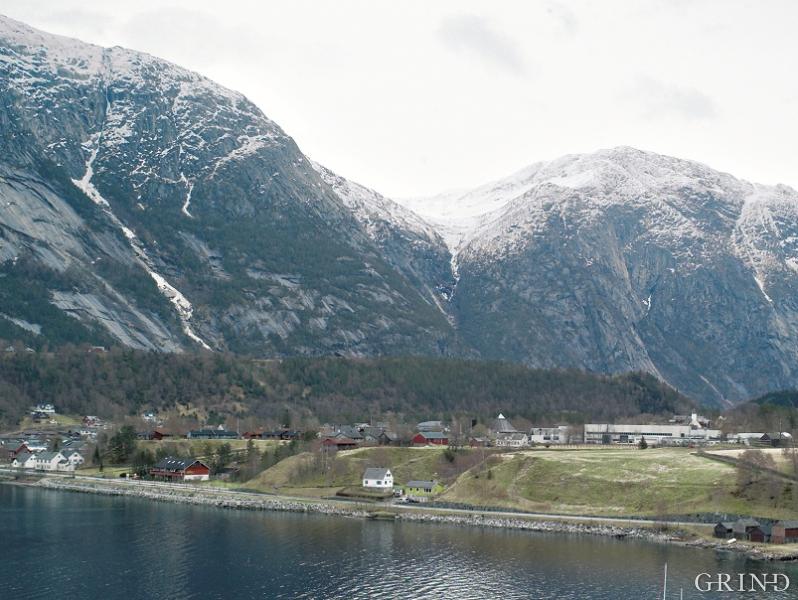Publisert: 19.05.2009 | Forfattar: Johan Naterstad
Hårteigen. From Veigdalen, Hardangervidda (Svein Nord).
If you have passed Fossli on your way eastwards, where the Vøringsfossen waterfall plummets down the ravine carved by the Ice Age, a little further ahead you will look straight at Grytehorgi in Sysendalen. A straight line in the rock face reveals a clear change in colour, light below and dark above. What you are seeing is the interface between light bedrock granite and younger black slate; an incomparable illustration in the geological book of history. If you climb one of the hills south of the main road and get a view of the lush landscape covering the slate, you will soon see Hårteigen rise up as a stump in your field of view. The top is a small remnant of scoured mountains that once covered the entire plateau and most of Hordaland.
Geology opens our eyes to that which has formed our landscape and the basis of our cultures. In the sea-scoured rocks along the beaches and the ice-scoured rocks in the mountains it is easy to discover and wonder about the diversity of materials, colours and structures. But what we see has a story to tell about an important part of the natural basis. It took the geological processes billions of years to bond the bedrock together. A further hundreds of millions of years were spent shaping the main features of the landscape from the foundation. The final polish of the landscape and the scattering of gravel and soil to grow grass and corn took a mere 10-12,000 years–a mere blink of the eye in the history of the earth.
The foundation
The rock bed in Hordaland may be divided into four main levels. The folding and breaking-up of this large package has caused the top level to not always appear at the topographically highest level, as the “icing on the cake”, so to speak. This is clearly visible in the schematic illustration.
The rock at the bottom level of the rock bed is often termed the bedrock. This rock was formed in prehistoric times, during the Precambrian era, as a result of different processes and at different times during this long period: east of the Hardanger fjord we find this rock unaffected by subsequent geological disturbances. However, in the bedrock areas towards the west and northwest the influence of more recent geological movements increases, particularly the Caledonian mountain-building, which took place 500 million years after the last bedrock granite had solidified. In the northwest area of the county the rock often displays visible structures, marked by both Precambrian and Caledonian processes, one on top of the other. It may therefore be difficult to determine what the rock has undergone.
What are visible are rocks formed from surface deposits, probably from sediments or lava, which is the oldest of the bedrock. There are only a few places where we may find remains of the even older base we know must have existed. Although the deposited rocks are usually to be found metamorphosed into gneiss, amphibole or quartzite, in the southeast of Hordaland we may still find traces in them from the processes that originally formed them; flow structures in lava or sloping or wave marks in sandstone.
In the western and north-western areas subsequent transformation has erased such primary structures, and there we mainly find these rocks as striped banded gneiss. Only pure quartzites may be accurately identified as ancient sediments, namely quartz sand.
In a few places, such as Røldal and Sveio, we can find the interface between such sedimentary rocks and the older gneiss base, but the remains of the sedimentary rock and their base mainly lie “floating” in a sea of younger igneous rock such as gabbro and granite. Gabbro is least common, but it is an important rock type as it is more subject to weathering and richer in plant nutrients than granite.
The vegetation and the smooth shapes give the gabbro landscape away. In Kvinnherad, in Jondal and many places on both sides of Sørfjorden we can find small areas of red, weathered serpentine and softer soapstone at the bedrock gabbro. Various types of granite, often transformed into gneiss, is the youngest and most common rock type in the Hordaland bedrock. Around the large granite fields we can occasionally find a rock mixture where dark, unmelted gneiss remains, penetrated by lighter, molten and intrusive granite, has been folded and kneaded together. This rock mixture is called migmatite and is common in all bedrock areas in Hordaland.
The youngest rocks between the granite, approximately 900 million years old, are channels of pegmatite. This particularly coarse-grained rock is common in gneiss and granite areas. There has been mining for feltspar and quartz in such channels, both in Sveio and close to Matre in Kvinnherad.
Sea over Hordaland
The transformation of Precambrian sedimentary and igneous rocks into gneiss, and the intrusion of granite into them 900 million years ago, took place many kilometres below the earth’s surface, deep below thick layers of rock. Following a long period of erosion, the Precambrian base was ground down to an incredibly flat surface, a peneplain, at the same level as the prevailing sea level. This plain gradually sank and was flooded by the sea. Deposits on the seabed slowly covered the entire eroded surface with thick layers of gravel, sand, clay and lime sludge.
The gravel along the shoreline is now found transformed into conglomerate; the sand strata have become quartzite; the clay has become black and grey phyllite or mica schist. The lime sludge has fossilised as limestone or marble. We know that the deposits are from the early paleozoic era because fossils have been found several places in the strata.
Across a large section of the western plain the hard bedrock is still covered by early paleozoic deposits, while little remains towards the east. The people of Hordaland have been lucky; much of the slate has a high content of lime and breaks down easily, providing good pastures even at this altitude. It is no coincidence that many of the old mountain farms are located on slate ground.
Where limestone appears at the surface, foliage is particularly lush. The slate in the top strata has a higher content of quartz and is harder than the strata below. Where this appears at the surface in large areas to the southwest of the Hardanger plateau, there is more bare rock and thinner soils are prevalent.
The Stone Age hunters on the plateau used both slate, quartzite and pure quartz from “dvergastein”, rock crystal, as material for arrowheads. The rock crystals, which are found in cavities and in cracks in slate and quartzite on the plateau, are among the most beautiful to be found.
Where erosion later has worked its way through the layers and down the much harder bedrock base, this will often create a shelf or mountain ledge where the old, level erosion surface is exposed. Many of the names containing sete (seat), hjadl or hjell (shelf) indicate landscapes that have been formed in this way.
Greetings from greenland
The third main level of the block diagram is overskuva, transported bedrock types. The transported rock lies above the fixed bedrock with a layer of early paleozoic sedimentary rocks on top. But the transported rock is not, as the illustration may indicate, a continuous rock sheet. According to different characteristics, the geologists divide the transported rock into small units, which are called skyvedekke or skyveflak (sliding sheets or flakes). The block diagram shows how such layers lie on top of one another.
There is reason to believe that much of the transported rock originated outside of Hordaland, presumably in the area west and northwest of the county. There are even those who believe that parts of a North American-Greenland sheet of crust has made its way to Hordaland! Whatever the case may be, we also find in the sliding flakes rock types that bear great resemblance to those found in the fixed base. We can find similar old, gneiss-like igneous and sedimentary rocks also in the sliding sheets, particularly in sheets in the Røldal mountains, in the Voss area, in Kvam and in Fusa.
A characteristic of the actual sheet surface, where the great mountain sheets have moved across the base, is that all of the rock types in the cover are thoroughly metamorphosed, crushed and recrystallised to slate-like, often hard and resistant rocks that are commonly called mylonite or mylonite gneiss. The rocks at the soles of the covers have often become schistous. It is typical that many slate and rock quarries are found in or near such shove zones. This applies to Voss, Jondal, Valestrand and Austestad in Fusa.
Deep sea seabed on dry land
The top level of the bedrock is orogenic Cambrian-Silurian rock. This is the area most varied and rich in resources in Hordaland. Fossil discoveries indicate that they are of the same age as the deposits that cover the bedrock on the plateau. These rocks are also orogenic, originating far beyond Hordaland.
Geologists believe that the oldest rock in this level are remains of the earth’s crust below an ancient deep sea, a “pre-Atlantic” ocean between what at the time was “Scandinavia” and “Greenland”. This sea was squeezed together and disappeared during the Caledonian mountain-building. Remains of such an ancient seabed are found on Gullfjellet mountain and several places along the northwestern side of the Hardanger fjord.
The rock in these remains is gabbro, and also includes serpentine and soapstone. Basalt, in the shape of lava shelves and in cavities is also common. The basalt is now mostly metamorphosed to green slate and greenstone. Both soapstone and greenstone have been important raw materials for tools in earlier ages. Many of the important deposits of pyrite and iron ore, which previously were the source of many jobs in Hordaland, lie between the basaltic lava rock. The gold at Bømlo was also found in quartz veins related to these oldest seabed remains. Rock originating from typical deep sea sediments also belong to this group: carbon-rich, black slate and flint-like quartz strata resulting from siliceous deposits on the seabed. The latter were raw materials for tools for the Stone Age inhabitants.
Younger than these remnants of ancient seabed are large amounts of flaky mica slate and phyllite, rich in plant nutrients and containing strata of conglomerate, quartz slate and limestone. The phyllite areas are thus green and fertile. The limestone is frequently transformed into marble and has in many places been quarried and used for various purposes up until our age. Most of the fossil finds in Hordaland have been made in limestone and lime-rich slate. Between the youngest parts of the strata in this level there are also many types of igneous rock and large amounts of intrusive igneous rock. Both gabbro and granite have penetrated the strata. Granite of this type makes up much of the bedrock on the islands in the mouth of the Hardanger fjord and northwards in Austevoll. Here, granite has been quarried for building purposes and street surfacing.
From folded mountains to plains
In the late Silurian age the Caledonian mountain-building and orogeny was well under way. It was during this age that the great folding pattern with lateral cracks was created, where the valleys and fjords in what later was to be called Bergensbogane was excavated. In the same way the folding pattern, which subsequently was to determine the shape of the Hardanger fjord, was created at this time. The geologists term this diagonal belt through Hordaland the “folded ditch”. It is clearly indicated on the block diagram.
The area has been land for most of this long time, which means that it has been subject to erosion, shaping of the landscape in the rock base. The rock that has been removed has been transported as gravel, sand and clay into the North Sea basin. By studying these areas, we may obtain some knowledge of what was happening on shore, with regard to landscape and climate. The mountains were slowly flattened.
However, the process was not a smooth one. Countless fissures and faults criss-cross the folded bedrock of Hordaland. Many of these arose after the culmination of the Caledonian orogeny. Proof of this may be found in Sunnhordland in the shape of a number of narrow intrusive veins from melting that have found their way along the fissures from great depths in the crust. Radiometric dating has shown that their ages range from Devonian, Carboniferous, Triassic periods up until the middle of the Jurassic period, 165 million years ago. These are the youngest intrusive rocks in Norway.
Crushed rock in the fissures and faults later enabled water and ice to shape countless small and large valleys and ravines, fjords and inlets that run across all rock boundaries. Particularly significant, and important for communications, are the many fjords and inlets running north-south in the county’s coastal area. This area did not attain its present form until later.
There is reason to believe that when the earth’s Mesozoic era ended with the Cretaceous period, most of Hordaland was levelled to a plain without many elevated features.
Hordaland towards new heights
We obviously do not know exactly what the landscape looked like upon the advent of the Paleogene period 65 million years ago. There was probably a rather low plain sloping evenly westwards towards a coast that was perhaps 20 km further out to sea than it is today. The land had wide valleys with no great differences in altitude. Even the highest parts of this landscape in inner Hordaland, from the Folgefonn area and inwards onto the mountain plateau, were probably no more than 500 metres in height.
But then, in the era of the Paleogene period known as the Eocene epoch, this landscape, along with large parts of western Scandinavia, was lifted high up. It is particularly the study of the distribution and character of the deposits below the North Sea seabed that has provided us with knowledge of what took place.
Geologists believe that the lifting of western Norway, which started approximately 50 million years ago and continued through the Paleogene period, is related to the widening of the Norwegian Sea between Norway and Greenland, which took place at the same time.
The water temperature along the beaches of Hordaland was probably in the range of 27ºC in the early Paleogene period. These good conditions for deep erosion and periods of abundant rivers to wash away the products of erosion laid the basis for creation of a river-excavated landscape in what was a relatively highly elevated Hordaland. It is important to note that when the ice covered Hordaland at the end of the Paleogene period, it was this river-excavated landscape that steered the large glaciers on their way towards the sea.
Are any of the Paleogene landforms still to be seen in Hordaland? Yes, there is a lot to indicate that this is the case. The typical characteristic of the landscape that appears when we see how the peaks gradually become lower when we move westwards is probably a reflection of a basic characteristic of the ancient landscape.
We further see in several places in the county, particularly in Kvinnherad, that the tallest peaks are smooth at the top with steep, sharply cut edges towards the ice-carved landscape below and around. It doesn’t take much imagination to connect the gentle, rounded shapes of these peaks together and envision a completely different, gentler landscape than what we see today. And even though these surfaces are seas of naked boulders carved by frost, they are probably the remains of landscape many millions of years old. At one time it lay beneath the subtropical sun and rain with the associated soil, plant and animal life.
The transition we see between the open Bjoreidalen valley to the northwest of the plateau above Fossli and the sharply and deeply cut Måbødalen, probably demonstrate how the remains of a Paleogene river valley has been transformed by ice and meltwater during the Neogene period. The even and gently sloping shoulders high above the cliffs of the Måbødalen valley are the remains of the valley sides of the old Bjoreidalen valley. And if we follow the shoulders up to flat summits one each side, we approach the remains of an even older landscape.
From tropical heat to long, harsh winter
When the Tertiary period came to an end approximately 2.5 - 2 million years ago, the warm weather was coming to an end. It was still humid, but it was colder, and when this change occurred in a landscape with peaks that could trap the precipitation and stay cold for a major portion of the year, it resulted in the snow building up year-on-year until finally turning to ice.
Small glaciers in depressions and on north-facing slopes linked up to form larger glaciers and plateau glaciers above the peaks. Finally the plateau glaciers joined up and created an ice cap. The Quaternary Ice Age had begun.
During the Quaternary Ice Age there were several ice-free periods in between the glacial periods.
Along the coast of Hordaland there is a very significant major feature, the coastal plain, that cannot solely be attributed to the latest Ice Age. The coastal plain rises slowly from the seabed in the skerries and in to the lowlands until it abruptly encounters steeper and higher coastal mountains at an altitude of 30 – 80 metres. The plain is chiselled from bedrock and is shaped like a shelf, cut into the old Tertiary landscape. At that point this had already been lifted, with peaks of at least 500 m in height.
Frost erosion and sea ice were the most important factors for the shaping of this surface. And since it is primarily in the periods just before and after the great and small glacial periods that the conditions for changing freezing and thawing have been best, it is easy to imagine that the shaping of the coastal plain took place in these periods; approximately 1 - 2 million years ago.
This landscape is not only to be found along the coast facing the ocean. It is also found in the fjords. This is particularly present in northern Hordaland, where broad heather moors are abundant. It is certain that the coastal plain greatly affected the subsequent population of the coastal areas of Hordaland.
There is a lot of evidence to suggest that the coast of Hordaland may have been free of ice during much of the early glacial periods. And although there are no traces of them, it is highly likely that humans have travelled along the coast then – occasionally displaced by the ice.
During the last great Ice Age, the ice cap was at its largest as late as 20,000 years ago. Many believe that the ice cap over Scandinavia reached across to – and connected to – a smaller ice cap over northern England and Scotland, so that Hordaland and Scotland were “connected by ice” so to speak. Others believe that the two ice caps never connected. Parts of Hallingskarvet, the Kvinnherad mountains and Tyssnessåta may have penetrated the last great ice cap.
The great spring
The melting and rebound after the last Ice Age took many thousands of years. The first islets and rocks were free of ice approximately 13,000 – 12,500 years before the present. The ice edge first melted as far east as just outside Bergen, before a cooler period forced the edge to move westwards again. From approximately 12,100 years ago the melting proceeded, and the ice edge moved far inwards into Hordaland. The ice had gone, at least at the fjord level, as far inwards as Eikangervåk,Trengereid, Ølve and Valen.
Then, between 11,000 and 10,000 years ago the climate again became cooler so the glaciers grew and the ice front moved westwards again. The western boundary of this advance is easily identified in Hordaland’s landscape. End moraines and large deposits from glacial rivers define the boundary more or less continuously from Etne in the southeast to Fonnes in the northwest. There is a lot of good agricultural land on these deposits.
Because this front position is so well defined, it indicates that glacial growth and melting has been in balance for a longer period. But approximately 10,000 years ago there was a 400-year period of rapid melting before a new short period of cooler weather stopped the melting once again, this time with the ice edge stopping to the east along the western edge of the Hardanger plateau. In the mountain areas south of Fossli the halt of the glacier front is particularly obvious. The beautiful side moraines over Fruo and Allgarden have been protected as natural monuments, and they are well worth a deviation from the main road.
Following this last stand of the glacier, melting proceeded quickly. It is estimated that the plateau was free of ice approximately 9,000 – 8,500 years before the present.
For the subsequent settlement of Hordaland, however, the most important event of the melting was that the rivers carried out the finer loose material left by the ice and deposited them where they reached the sea and fjords. At the river mouths wide, shallow banks were built up and extended far out into the fjords and sea. In some places, entire fjord estuaries were filled in.
It is the soils from these fjord fillings that have provided most of the cultivated land in Hordaland, and compared with the moraine soil, which is rich in rock, it is also the most easily cultivated.
This has come about because the rock base, with the fjord fillings on top, slowly rebounded above sea level when the weight of the ice was removed. The meltwater from all the ice probably caused sea levels to rise too, but in sum this was less than the elevation of the rock base. In any case it resulted in the flat banks being elevated above sea level, and the rivers were forced to find new ways to the sea through the deposits they had previously carried into the fjords.
Through excavation and depositing the river would move over large sections of the bank and even it into a new plain with a steep edge up to the old one. This would have happened many times as the land rose, until the river was tamed by the sea or by a hard threshold that had to be crossed. This is how the terraced landscape that is so common in many places in Hordaland was formed.
The net rebound varies. Even though the coast was free of ice first, the highest of the raised coastal deposits are only approximately 30 metres above the current sea level, while those innermost in the fjords, such as Hareid in Eidfjord, are 120 metres above sea level. The maximum heights gradually increase inwards. In Kvinnherad the maximum heights are 70 to over 80 metres.
The geological processes are also at work today. At Folgefonna, Hardangerjøkulen and other smaller glaciers, the ice fractures and grinds the rock, the rivers dig and transport, earth and rocks move and slide as avalanches, and out at the coast the waves pound solid rock and deposits and shape the landscape.
Human beings are also a factor to take into account with regard to reshaping the landscape. Power plants, roads, small and large construction sites – digging, filling and shaping take place everywhere. We are currently experiencing a relatively warm period following the last Ice Age, a so-called post-glacial period. But if we believe that a new Ice Age is underway, a few thousand years forward in time, then we are living in an inter-glacial period and the construction industry can look forward to a longer, cool break.
- Mangerud, J. (1976) Fra istid til nåtid. I: Hartvedt, G. H. red. Hordaland og Bergen. Bygd og by i Norge. Oslo, Gyldendal, s. 111-151.
- Naterstad, J. Fjellgrunnen: utgangsmaterialet for alt liv.

